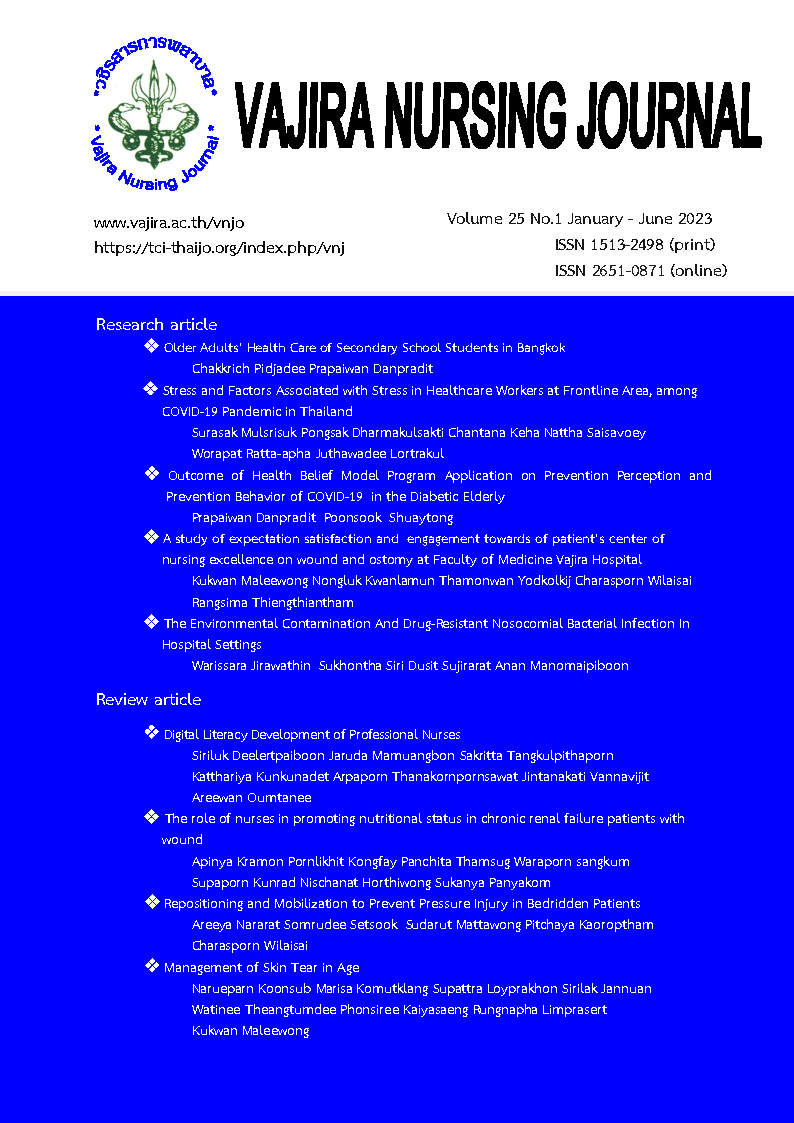ความเครียดและปัจจัยที่มีความสัมพันธ์กับความเครียดในบุคลากร ทางการแพทย์ด่านหน้าที่ปฏิบัติงานในช่วงการแพร่ระบาด ของโรคติดเชื้อไวรัสโคโรนา 2019 ในประเทศไทย
Main Article Content
บทคัดย่อ
บุคลากรทางการแพทย์ด่านหน้าที่ปฏิบัติงานในช่วงการแพร่ระบาดของโรคติดเชื้อไวรัสโคโรนา 2019 มีโอกาสสูงที่จะเกิดความเครียดเนื่องด้วยภาระงานที่มากและการบริหารจัดการยังไม่เอื้อต่อการปฏิบัติงานให้มีประสิทธิภาพ การศึกษาครั้งนี้จึงให้ความสำคัญต่อการวิเคราะห์ปัจจัยที่นำไปสู่การเกิดความเครียดด้วยการใช้การศึกษาแบบตัดขวางรวมถึงการใช้สถิติเชิงพรรณนาและสถิติวิเคราะห์ถดถอยโลจิสติกพหุเพื่อให้ทราบถึงปัจจัยที่เกี่ยวข้องกับความเครียด การรวบรวมข้อมูลได้จากแบบสอบถามออนไลน์จากบุคลากรทางการแพทย์ที่ปฏิบัติงานด่านหน้าโรงพยาบาลศิริราช จำนวน 558 ราย ซึ่งประกอบด้วยข้อมูลส่วนบุคคล สุขภาพ ความต้องการพื้นฐานในการปฏิบัติงาน และแบบประเมินภาวะสุขภาพจิต (DASS-21) ฉบับภาษาไทย
ผลการศึกษาพบว่า ภาวะเครียดเกิดในบุคลากรทางการแพทย์ร้อยละ 23.3 และปัจจัยที่เกี่ยวข้องกับการเกิดความเครียดประกอบด้วย ปัจจัยด้านวิชาชีพ (พยาบาล (OR = 4.62; 95% CI: 8.90–28.10) พนักงานทั่วไป [OR = 13.72; 95% CI: 2.48–76.03] และพนักงานเคลื่อนย้าย (OR = 2.75; 95% CI: 0.17–45.57) รวมถึงการมีอุปกรณ์ในการป้องกันตนเองไม่เพียงพอ (OR = 1.75; 95% CI: 1.06–2.88) ภาระงานที่ได้รับมอบหมายไม่เหมาะสม (OR = 2.45; 95% CI: 1.44–4.15) การมีโรคประจำตัว (OR = 2.82; 95% CI: 1.62–4.92) และคุณภาพการนอนไม่เพียงพอ (OR = 0.38; 95% CI: 0.24–0.60) โดยสถิติทดสอบระดับความสัมพันธ์ของปัจจัยดังกล่าวกับการเกิดความเครียดในบุคลากรทางการแพทย์ด้านหน้าอยู่ที่ร้อยละ 36.2 (Nagelkerke R2 = 0.362) ผลการศึกษาครั้งนี้เป็นประโยชน์ในด้านการใช้ข้อมูลสำหรับดำเนินการวางแผนจัดการความเครียดเชิงป้องกันในบุคลากรทางการแพทย์ที่ปฏิบัติงานด่านหน้าทั้งในภาครัฐและเอกชนได้อย่างมีประสิทธิภาพ
Article Details

อนุญาตภายใต้เงื่อนไข Creative Commons Attribution-NonCommercial-NoDerivatives 4.0 International License.
เนื้อหาและข้อมูลในบทความที่ลงตีพิมพ์ในวชิรสารการพยาบาลถือเป็นข้อคิดเห็นและความรับผิดชอบของผู้เขียนบทความโดยตรง ซึ่งกองบรรณาธิการไม่จำเป็นต้องเห็นด้วย หรือร่วมรับผิดชอบใด ๆ ทั้งสิ้น
บทความ ข้อมูล เนื้อหา รูปภาพ ฯลฯ ที่ได้รับการตีพิมพ์ในวชิรสารการพยาบาล ถือเป็นลิขสิทธิ์ของวชิรสารการพยาบาล หากบุคคลใดหรือหน่วยงานใดต้องการนำทั้งหมดหรือส่วนหนึ่งส่วนใดไปเผยแพร่ต่อหรือเพื่อกระทำการใด ๆ จะต้องได้รับอนุญาตเป็นลายลักอักษรจากวชิรสารการพยาบาลก่อนเท่านั้น
เอกสารอ้างอิง
Yashavantha Rao HC, Jayabaskaran C. The emergence of a novel coronavirus (SARS‐CoV‐2) disease and their neuroinvasive propensity may affect in COVID‐19 patients. Journal Medical Virology 2020; 92(7): 786-790.
Salari N, Hosseinian-Far A, Jalali R, Vaisi-Raygani A, Rasoulpoor S, Mohammadi M, et al. Prevalence of stress, anxiety, depression among the general population during the COVID-19 pandemic: a systematic review and meta-analysis. Global health 2020; 16(1): 1–11.
World Health Organization. Weekly epidemiological update on COVID-19. Geneva: WHO; 2021.
Bandyopadhyay S, Baticulon RE, Kadhum M, Alser M, Ojuka DK, Badereddin Y, et al. Infection and mortality of healthcare workers worldwide from COVID-19: a systematic review. BMJ glob health. 2020; 5 (12): e003097.
Dutheil F, Mondillon L, Navel V. PTSD as the second tsunami of the SARS-Cov-2 pandemic. Psychol med 2021;51(10):
–1774.
Shaukat N, Ali DM, Razzak J. Physical and mental health impacts of COVID-19 on healthcare workers: a scoping review. Int J emerg med 2020; 13(1), 1-8.
Khanthacha K. Factor associated with Stress of Healthcare Workers at Tambon Health promotion Hospital Nakhonphanom Province, during The Corona Virus Disease 2019 (COVID-19) Outbreak. RDHSJ 2022; 15(2): 285-299. (in Thai)
Department of Mental Health. Stress Relief Manual. 6th ed. Bangkok: Design con; 1998.
Suksupa N, Jittitaworn W. Stress and Fear on the Duty Awareness during COVID-19 Outbreak of Registered Nurses, Chareonkrung Phacharuk Hospital. J Royal Thai Army Nurses 2022; 23(3): 457-469. (in Thai)
Kajai C, Suksatan W, Promkunta N, Kamkaew N. The relationships between stress, stress-coping behaviors, and suicidal risk among Thais who had become unemployed due to the COVID-19 pandemic: A cross-sectional study. Belitung Nurs J 2022; 8(5): 446-452.
Nguyen NPT, Le DD, Colebunders R, Siewe Fodjo JN, Tran TD, Vo TV. Stress and Associated Factors among Frontline Healthcare Workers in the COVID-19 Epicenter of Da Nang City, Vietnam. Int J Environ Res Public Health 2021; 18(14): 73-78.
Rony MKK, Bala SD, Rahman MM, Dola AJ, Kayesh I, Islam MT, Tama IJ, Shafi EH, Rahman S. Experiences of front-line nurses caring for patients with COVID-19 in Bangladesh: A qualitative study. Belitung Nurs J 2021; 7(5): 380-386.
Lai J, Ma S, Wang Y, Cai Z, Hu J, Wei N, et al. Factors Associated with mental health outcomes among health care workers exposed to coronavirus disease 2019. JAMA Netw Open 2020; 3(3): 76–86.
Saimai P, Yodbute S, Norasan S, Unhasuta K. Stress among charge nurses at a university hospital in Bangkok, J Public Health 2014; 44(2): 174-188. (in Thai)
Sangsirilak A, Sangsirilak S. Stress and Depressed Mood in Healthcare Workers During COVID-19 Outbreak. J Psychiatr Assoc 2020; 65(4): 401-408. (in Thai)
Saisavoey N, Reporting the results of a questionnaire for staff of the Faculty of Medicine Siriraj Hospital in the situation of the novel coronavirus outbreak, at the 3rd Quality Conference (2020, New Ways of Management) Human Resources from Covid-19 Situation, 30 June 2020 at Meeting Room 203, Srisawarintira Building, 2nd Floor; 2020.
Comrey, A. L., Lee, H. B. A First Course in Factor Analysis. 2nd ed. New Jersey: Lawrence Erlbaum; 1992.
Lovibond PF, Lovibond SH. The structure of negative emotional states: Comparison of the Depression Anxiety Stress Scales (DASS) with the Beck Depression and Anxiety Inventories. Behav Res Ther 1995; 33(3): 335–343.
Oei TPS, Sawang S, Goh YW, Mukhtar F. Using the Depression Anxiety Stress Scale 21 (DASS-21) across cultures. Int J Psychol. 2013 Dec; 48(6): 1018–1029.
Elbay RY, Kurtulmuş A, Arpacıoğlu S, Karadere E. Depression, anxiety, stress levels of physicians and associated factors in Covid-19 pandemics. Psychiatry Res 2020; 290: 113-130.
Srivastava A, Srivastava S, Upadhyay R, Gupta R, Jakhar K, Pandey R. Stressor Combat Strategies and Motivating Factors Among Health Care Service Providers During COVID-19 Pandemic. Cureus 2021; 13(4): e14726.
Promsarn S, Promsarn P, Rattanasaengloet K. Stress and burnout of healthcare worker (HCW) at Siriraj Hospital during the medical treatment of COVID-19 patients. J Royal Thai Army Nurses 2021; 74(3): 197-204. (in Thai)
Tosepu R, Gunawan J, Effendy DS, Rustam HN M, Muchtar F, Sakka A, Indriastuti D. Experience of healthcare workers in combatting COVID-19 in Indonesia: A descriptive qualitative study. Belitung Nurs J 2021; 7(1): 37-42.


